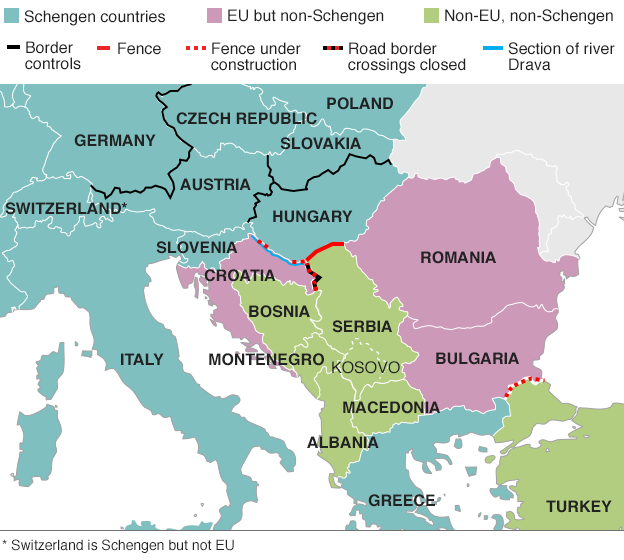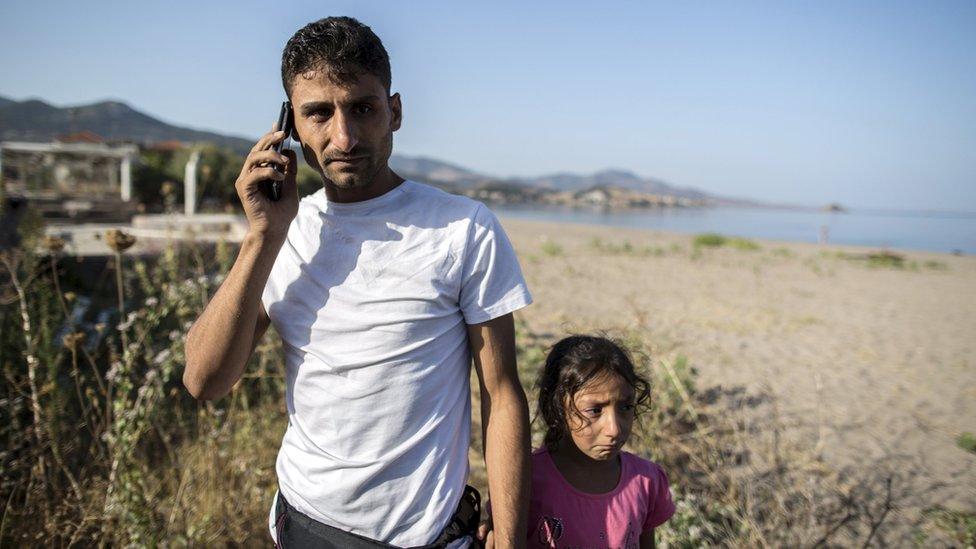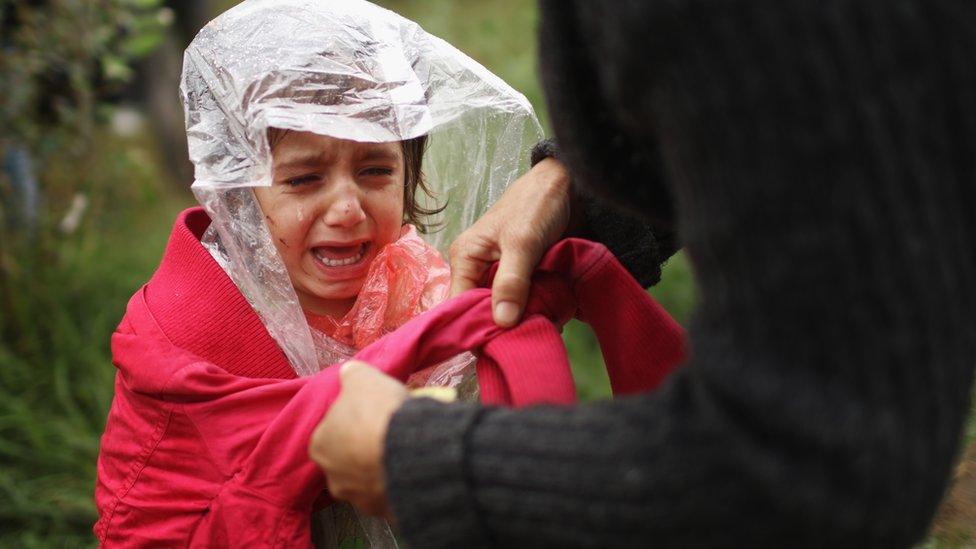Migrant crisis: What is the next route through Europe?
- Published

People from Syria, Pakistan and Afghanistan cross into Croatia
After Hungary sealed off its border with Serbia, thousands of migrants travelling through Europe have been faced with the challenge of finding a new route.
And with other EU countries boosting border controls, the long journey to a new life in Germany - or another preferred destination - has become even more complicated.
Meanwhile European governments are rushing to cope with the huge number of people on the move.
Where will they go?
Crowds found themselves blocked at Serbia's border with Hungary, after the government of Prime Minister Viktor Orban completed a razor-wire fence to stem the influx.
Large numbers have now crossed instead into Croatia, which is not in Europe's passport-free Schengen zone.
The authorities there had initially said they were ready to receive the migrants or "direct" them to where they want to go. Later they said they were overwhelmed and would only move people on.

Croatia has said it will "force" Hungary to accept migrants by sending groups to the two countries' common border. Meanwhile Hungary is rushing to erect a fence along this boundary, too.
There are other options for alternative routes but none is straightforward, says Martijn Pluim of the International Centre for Migration Policy Development (ICMPD).
Going east through Romania is an option in order to avoid Croatia, he says. But it is likely to lead people back into Hungary, which has also pledged to build a new fence on its Romanian border.
Crossing into Bosnia is more difficult, and only a detour.

Passing from Serbia into Croatia and then into Slovenia initially seemed to be the easiest option, due to the infrastructure and transport network available.
But Slovenia has tightened security and on Friday a group of migrants trying to cross the border were met with pepper spray.
So migrants could increasingly look to other options.
'Extreme lengths'
Small numbers have begun travelling from Greece to Albania then Italy by boat, according to reports.
But the journey across the sea - popular with Albanians crossing to Italy in the 1990s - is risky, with rough waters.
More than 2,600 migrants, including three-year-old Alan Kurdi, have drowned trying to cross the Mediterranean since January this year, according to the International Organization for Migration (IOM).

Alan Kurdi, left, and his brother Ghalib are among those who drowned at sea
Thousands of migrants at Europe's southern frontier have sought to avoid the dangerous maritime route between Turkey and Greece, walking to the Turkish border town of Edirne, 10km (six miles) from the Greek border and 20km from Bulgaria.
But Turkish security forces have tried to block their route and local officials in Edirne have warned that they will send anyone trying to cross the border illegally back to refugee camps in southern Turkey.
There are also unconfirmed reports of Syrians detained in Odessa in southern Ukraine, according to Mr Pluim. They are believed to have taken a boat from Turkey across the Black Sea.
The BBC's Rengin Arslan reports on the migrants avoiding the sea and seeking to reach Europe by land
At the continent's northern tip, small numbers of people are believed to have crossed from Russia into Norway.

And there are reports of people walking along the Baltic coast to Finland, according to Elizabeth Collett, of the Migration Policy Institute (MPI).
"This demonstrates the extreme lengths people are willing to go to," she added.
Share advice on routes
Experts say the main assistance migrants ask for when they arrive at junctions in their journeys is information.
James Reynolds described the chaos as Hungarian police clashed with migrants
"They keep asking where can they go, where can they go for protection," said Melita Sunjic, spokeswoman for the UN's refugee agency UNHCR.
Many are increasingly turning to smartphones and social networks such as Whatsapp and Facebook to share advice on routes.
Getting a local Sim card or connecting to wireless internet allows the migrants to use GPS maps, search engines and booking sites.

Migrants are using phones and social media to both contact relatives who are already refugees in the EU and share information with other arrivals
It is a changing dynamic that has apparently taken some observers by surprise.
But it has also allowed well-connected migrants to avoid the services of people smugglers.
"The majority of people have used at one stage the service of a smuggler - from Turkey to a Greek island for instance," says Mr Pluim of the ICMPD.
"But for the most part of the trip they can do it on their own."
Changing climate
The large number of people heading for the European Union is expected to continue, with refugees still fleeing conflicts in countries such as Syria and Afghanistan.
But the political climate and the weather in the continent are more changeable.
The UN children's charity, Unicef, has announced it is increasing help for women and children at reception centres in Serbia and Macedonia, amid fears people could become stranded.
"As winter is approaching fast, the immediate needs for protection and care of children and pregnant women require urgent action," it said in a statement.

People have encountered heavy rain on their journey from Greece to the Hungarian border
Whereas bad weather is likely to deter people from dangerous sea crossings, the number of migrants travelling by land is not expected to decrease.
However, the people arriving at Europe's borders may differ.
Many of those so far have come from educated and well-off backgrounds, Mr Pluim says, but more and more migrants are expected to come from poorer families.
They will have fewer resources to spend on safe transport and shelter.
"People will arrive in a more destitute situation, but also when the weather isn't good," he says.
And there are concerns that countries such as Macedonia, Serbia and Croatia may not be prepared enough to cope.
A note on terminology: The BBC uses the term migrant to refer to all people on the move who have yet to complete the legal process of claiming asylum. This group includes people fleeing war-torn countries such as Syria, who are likely to be granted refugee status, as well as people who are seeking jobs and better lives, who governments are likely to rule are economic migrants.